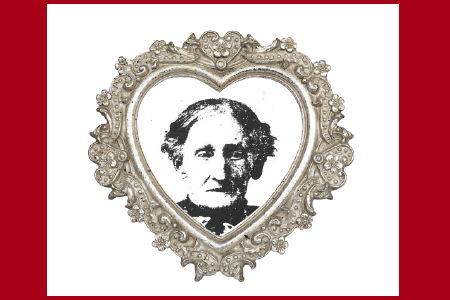
In honor of Valentine’s Day, I bring you a story about beaux and courtship in the little town of Cicero, Indiana. Written by a wonderful storyteller, Mary A. Barnett, and first published in 1923, she brings to life what dating was like during her teenage years in the Civil War era. Funny, honest and very human, the “Autobiography of Mary A. Barnett and History of the Barnett Family” is a jewel among our family genealogy section. You may recognize the name, as Mary A. shares a close family tie to Nancy Kerlin Barnett, the woman whose grave is buried in the middle of the road in Amity, Indiana.
Coming of age for Mary ushered in an era of her life when school functions and church services brought young people together. Just as middle and high school athletic functions, school and church clubs bring excitement and drama to kids’ lives, so did similar functions for Mary. A big event for children was the last day of school spelling bees. Held in the evenings, these events were hailed with joy and delight.
Mary writes that being invited to the neighboring last day of school exhibitions allowed for children to show off a new set of clothes. The boys would don their new suits, and the girls their new calico dresses. When boys of the neighborhood began to “show their respects,” Mary’s mother decided Mary and her sister Milda were old enough to switch from short skirts of little girls to long dresses of women. Feeling pretty confident in her new red striped calico dress, Mary decided she and her sister could “catch larger fish” than just the neighborhood boys.
It was the custom of the day for boys this age to form a line outside of an entrance door after the evening spelling bees. When a girl made her appearance as she walked through the line, the boys would use their most clever line to ask a girl if he could escort her home.
After one particular Spelling Bee event, Mary and Milda were escorted home by their beau. The dampness of the day caused their skirts to become damp from the knees down. The evening brought about a freeze which prompted the sisters to politely ask the boys to come inside and get warm by the fire, which is what they did. Now the girls were hoping the boys would refuse. They did not want her parents to know they had beaux and the “rattle of their frozen dresses” could be heard by the sleeping household. Nothing was said by the father for a few days until one day Mary’s father looked at her and said he thought the cows would be ever so thankful they wouldn’t have to lend their hide to cover those two boys’ big feet.
Mary continued to have boys who asked to walk home and “set up” with her. Mary would often join with a group to “set up” together at different houses of their friends. If a boy was particularly sweet on a girl, he might ask to be allowed to visit on Sunday evenings. Just like today, Mary’s parents liked some of the boys more than Mary did, and Mary liked boys that her parents did not. Sadly, the Civil War took many of these young men away. For Mary, she gave up quickly any interest in a boy who signed up for service in the war. It was generally accepted there was little hope of ever seeing or hearing from these boys again.
Mary followed her ambition to become a teacher and furthered her education. She married in 1872 to a cousin George Barnett and settled in Nineveh Township. She continued to teach and raise a family of five. Mary died after 1923. Before doing so, she left an account of her family history that is used today by many searching the lineage of the Barnett Family back to Pocahontas.
Please join us for our newly created Your House Conversation Group, March 6 in the Historical Room of the Franklin Branch. Newer house or historic, all are welcome. Together we will encourage each other and share information. Please register at pageafterpage.org/programs.


